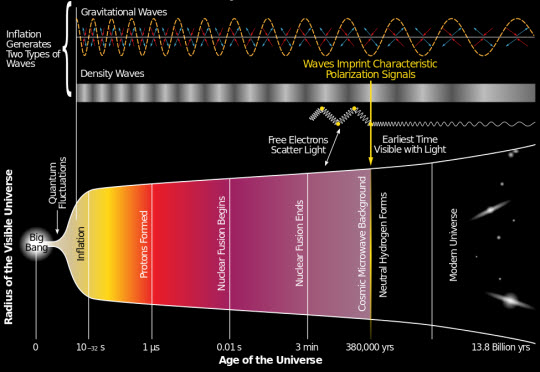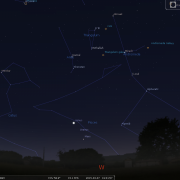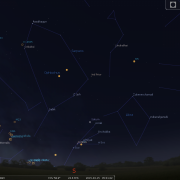Welcome to the WDAS monthly newsletter for March 2015: a digest of the month's latest contributions to our website. Below you'll find Society News, Sky Notes and In-Focus articles printed in full. There's also future events, and trailers for other articles which appear in full on the website - just a click away!
On the website you'll also be able to comment on articles, and if you'd like to play an editorial role in creating new content, just let us know!
If you don't see images in this e-mail, look for a setting in your browser or e-mail reader to display them; and if you have any other problems reading the newsletter please let us know the browser or e-mail program you're using, and we'll see if we can fix it.
Things to Remember in March:
- Next W.D.A.S monthly meeting is on Tuesday March 3rd. Mark will be speaking about the Partial Solar Eclipse and the Messier Marathon.
- The Spring equinox (and solar eclipse) occur on March 20th. We welcome your photos for the website.
- BST begins at 01:00h on March 29th. Clocks go forward 1 hour.
Society News
Lots of Members couldn't make it to the WDAS February meeting, so here's a brief round-up of events:
How the night sky will change
Mark often shows Star Party revellers how the slow wobble of the earth's axis has changed the pole star from Thuban in the constellation Draco at the time Egyptians were building the pyramids, to Polaris in Ursa Minor as we know it today.
But in his talk in the February meeting, Mark showed that in the 98 millennia between now and the year 99,999 CE not only will there be many cycles of the earth-axis-wobble, (precession) but many of the constellations themselves will morph into completely different patterns.
For example, the familiar 'W' shape of Casiopeia changes to something resembling an inverted jug. The nearer stars Ruchbah (2nd from the left) and inparticular, Caph (right) have moved the most.

And the saucepan-shaped 'Big Dipper' asterism in The Plough will change into something more like a wok, with a dodgy handle. (chop-sticks supplied!). The star at the end of the handle (Alkaid) and the upper 'pointer' star, Dubhe are the ones to break ranks.
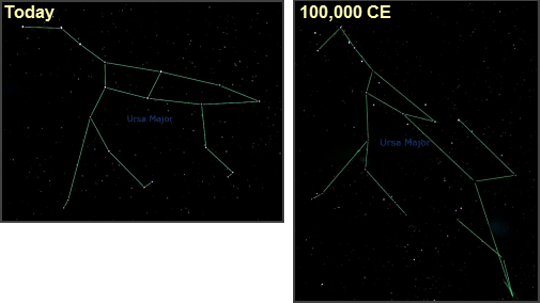
As well as stars changing apparent position from the perspective of our own solar system, due to their relative proximity, some stars are pretty close and heading in an different direction to the norm. One such star is the bright star Arcturus in Bootes; the brightest northern hemisphere star. Arcturus does not circle around the Gallatic Centre, but is plunging down through the galactic disk ahead of us (crossing our path). In a 100,000 yrs Arcturus will be in Virgo, indeed around 76200AD Arcturus and Spica will appear cheek to cheek in the sky, with Rigil Kentaurus steaming up from the southern hemisphere.
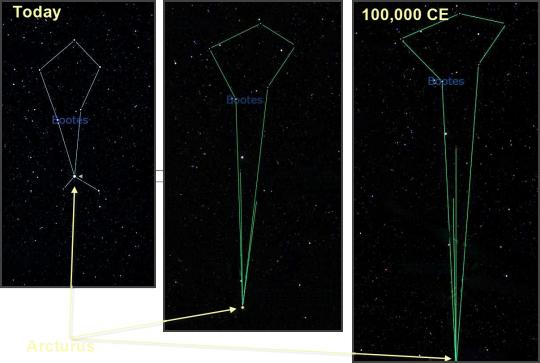
Still other stars may have winked out of existence entirely by the year 100,000 CE. Even now, we're waiting for Betelgeuse in Orion's left shoulder to explode in a supernova some time before then.
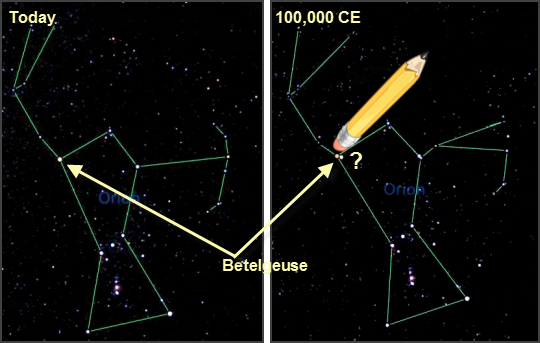
Inflation's signature in doubt
Andi showed a film-strip of last year's most significant astronomical discovery, and explained how new data has caused the discovery claim to be withdrawn.
Almost no time at all after the universe sputtered into existence, most cosmologists believe there was an imperceptibly brief but supremely fast period of expansion which has been called 'inflation'. It explains many of the characteristics we observe in the universe. But not everybody buys into the theory. In particular one renowned cosmologist, Roger Penrose, believes there are other ways to explain the universe we see today. So finding a 'smoking gun' of inflation would put the matter beyond doubt.
Through our telescopes we look back in history, because we observe light which has travelled since as long ago as 300,000 years after the Big Bang. But there we hit a wall, because up until that time the universe was too hot for atoms to form: electrons were not captured around an atomic nucleus, and in this state they scattered light such that the universe was opaque. We cannot 'see' as far back as the Big Bang. We can look back as far as the romantically named "last scattering surface" atoms formed and the universe became transparent. Today we observe light from this time as Cosmic Microwave Background Radiation (CMBR) which has already taught us much about the nature of the universe.
However there is a means by which we may obtain traces of the universe's earliest moments. It is thought that the rapid expansion of space by inflation would have released gravitational waves. These would have travelled unimpeded through space from the earliest times, and it is thought that their passage would have rippled space and polarised light in the CMBR. And it's this 'smoking gun' signature of gravitational waves that the BICEP team believed they had observed.

However, two factors had to be subtracted from the results received by the BICEP2 instrument at the South Pole before the gravitational energy could be concluded to be responsible, since they have an effect which is much the same as gravitational waves.
One was the gravitational lensing effect of large galaxies. And the other, much more significant factor was the effect of spinning particles of dust in the foreground of our own galaxy. The BICEP team used their best information to do this.
But since their announcement the Planck satellite, which can map the microwave sky at many more frequencies, has provided new data. It has found more dust. After re-calculating with this new data, the gravitational wave data cannot be separated from the 'noise' at statistically significant levels, and therefore the finding has been withdrawn. However, the improved data give a new platform for the BICEP team to do more research, so watch this space.
Although the news is certainly disappointing, it is greatly satisfying to see the rigour of the scientific method in action, and a great reminder of how it works. Every result is provisional: it will fall if contradicted by evidence. It is testable, and the more significant the claimed discovery, the more effort teams will expend trying to disprove it. In this case, the BICEP team believed with a certainty of 7σ (that there was only a 0.0000000001% chance that their result could have been an unlucky chance). And yet it was toppled by new data which humbled the team's best assumptions.
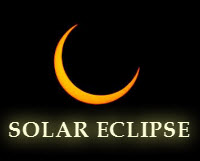 We are rapidly approaching what is undoubtedly one of the celestial highlights of the year, the spring equinox, which falls on March 20th. What, the spring equinox? Yes but, this year’s spring equinox will not be the anonymous affair it normally is, but will be marked with something rather more fitting, and for a lucky few, very much more memorable.
We are rapidly approaching what is undoubtedly one of the celestial highlights of the year, the spring equinox, which falls on March 20th. What, the spring equinox? Yes but, this year’s spring equinox will not be the anonymous affair it normally is, but will be marked with something rather more fitting, and for a lucky few, very much more memorable.
For a start, the moon turns new only 14 hours after reaching lunar perigee: the moon’s closest point to Earth in its orbit, so this moon is a super moon, actually a new super moon, normally not visible in our sky. However, this one will be as it swings in front of the Sun, causing a total solar eclipse to herald the return of spring....at least it will should you lie directly under the path of totality. (Much joy and anticipation in the Faroe Islands and Svalbard.)
Few phenomena rival this wondrous spectacle, a magnificent and coincidental outcome of planetary orbital mechanics, manifest all too briefly in action as our nearest star is occulted by the moon causing its shadow to cut a swath across a part of our globe.
As far as this particular swath goes, it's a case of 'near and yet so far' for the UK, with the moon’s shadow sweeping up across the north east Atlantic region between Iceland and Britain missing Scotland by a few hundred miles. But let's not be down cast, for a very substantial partial eclipse will be witnessed from our neighbourhood, which from Whitby will amount to around 91%, only 5% less than the 1999 eclipse, as seen from Whitby.
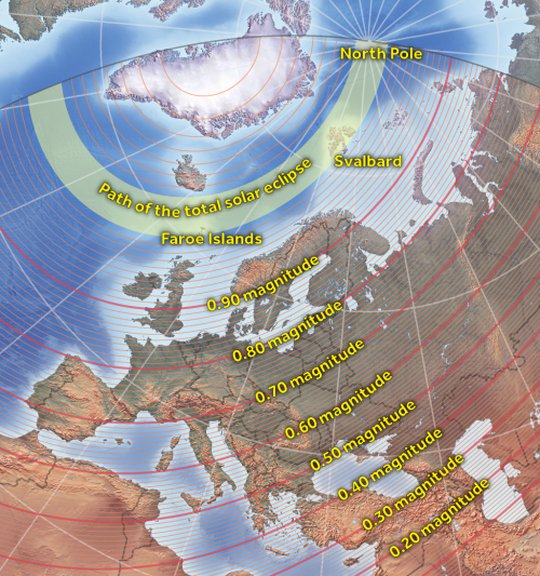
20th March Solar Eclipse: The path to totality - Whitby sees a 91% Eclipse
The eclipse is a morning event, with mid-eclipse occurring around 09:37h. The eclipse starts just over an hour before this, and ends around an hour after it, at 10:42h.

Viewing
As astronomers we should all know about the dangers of solar observing, but please do observe all due care and diligence when attempting to view the sun by whatever method chosen. Never look directly at the sun through optical aids or the naked eye without appropriate certified filters. If you do not have a suitable filter, use the projection method. If any society members require Baader solar sheet filter for use with their scope etc, we have a sizeable piece to be utilised. Safe methods and how to use solar film will be covered and demonstrated at our monthly meeting in March.
As regards the whereabouts of WDAS members on the morning of the 20th, the bandstand on pier road would seem to be the most practical choice. If the weather is fine we will be there from 08:15h until 10:30h.
Solar Observation - Safety Points
Observing a solar eclipse or any phenomena involving the Sun, such as a transit, safety is always of paramount importance. Never directly look at the Sun through any optical instrument unless a suitable solar filter is used, failure to do so and you could permanently damage your eyesight; remember the Sun is 1,000,000 times brighter than the Moon.
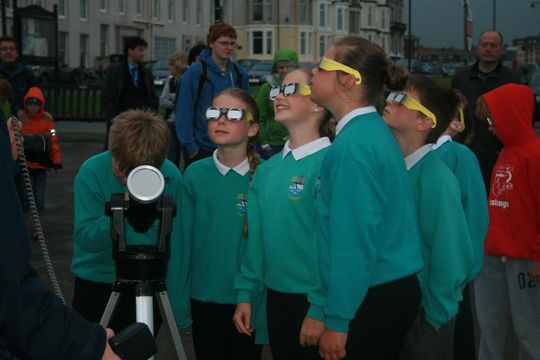
Filtered Scope and Solar Viewing Eye-specs method of viewing a Solar Eclipse
The small ‘screw on eyepiece’ type sun filters sometimes supplied with cheaper small telescopes can shatter due to excess heat - do not use them on any account – please introduce them to the head of a hammer-forcefully. Home-made filters such as smoked glass, exposed film negative and extra dark sun glasses do not stop harmful rays from penetrating your eyes. Do not be tempted to use them.
Use only authorised solar filters such as Mylar and Baader solar film which are 99.99% safe to use at the objective end of a telescope, do not use them across an eyepiece, You can also utilise solar spectacles or a No14 or above welders glass (hand held) for short periods of observation, but never wear solar glasses and look through an eyepiece at the Sun (yes I have seen people about to attempt this).
Unless you have the correct type of solar filter, the safest way to view the solar disc is by projection.
Projection Method
Items of equipment required:
- Telescope - a refractor or reflector - aperture size does not matter; in fact a smaller aperture size is more preferable as it cuts down heat transmission on lenses or mirrors.
- Binoculars can also be used, preferably tripod mounted, but be sure that the lens and eyepiece on one half are capped. (Obvious to astronomers, but apparently not so for everyone)
- You will also require a sheet of white card and ideally, a cardboard box.
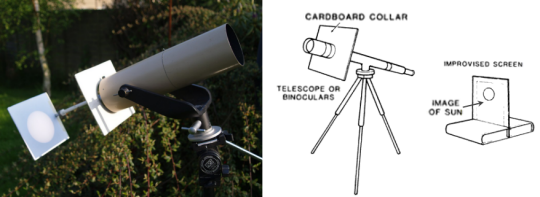
Projection Method of observing a Solar Eclipse
Projection is a simple technique for viewing the Sun, but care must still be exercised. Obtain a cardboard box and insert a piece of white card in the bottom of it (roughly A4 or A3 size or cut to the appropriate dimension of your box) Taking another piece of card approx 30-50cm square cut a hole in the middle of it just large enough for it slide snugly over the telescope or binocular tube. If using a star diagonal with your scope this second piece of card is not required.
Position the box around 1 metre behind the telescope or binoculars allowing the Suns image to fall onto it. To accomplish this:
- Semi-lock the telescope tube so that it can still be moved and aim in the direction of the Sun by sighting along it.
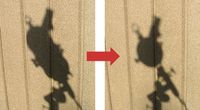 Make sure that end caps, including any finder scope caps are firmly in place. As an indication of how close you are, look for the smallest shadow cast by the tube onto the card in the box.
Make sure that end caps, including any finder scope caps are firmly in place. As an indication of how close you are, look for the smallest shadow cast by the tube onto the card in the box.- The telescope should then be aligned. Insert a low powered eyepiece and remove the telescope end cap, but not the finder scope ones. A bright circular disk should be visible on the card, this is the suns image. Adjust the focus accordingly until the image becomes clear and sharp revealing any features visible on or against its disc.
In the case of a solar eclipse the dark silhouette of the lunar limb will be apparent.
This procedure can take a little time if you are unfamiliar with the movement of a scope, so don’t get frustrated and be tempted to look through the eyepiece, this is how accidents happen.
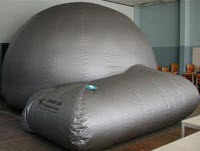 As you will have read last time we have been invited to assist at the forthcoming ‘star night’ at Eskdale school on March 4th (the night after our March meeting).
As you will have read last time we have been invited to assist at the forthcoming ‘star night’ at Eskdale school on March 4th (the night after our March meeting).
If skies are clear we will be taking several scopes up, as well as the laptop and projector (plan B).
Any members wishing to assist on the evening please be at Eskdale School for 6:30pm (front door car park).
The Telescopes have to transported through the main hall and erected at the back of the school, hopefully observing Jupiter, Orion etc.
I believe hot soup, buns, tea and cakes will be available to warm the cockles should it be a chilly evening.
- Although the majority of subs are now in. If you haven’t renewed but intend doing so, time is running short as we ideally would like existing renewals to be completed by mid March.
Subs for 2015 are Adults: £12, Under-16s: £5
Any Cheques made payable to: Whitby & District Astronomical Society.
Please address to Mark. - All the the copies of Night Scenes 2015 purchased by the society have now been snapped up by members. If you wish to purchase a copy and can wait until April, Paul Money will no doubt have some copies when he travels up to speak in April.
Sky Notes
In this month's Sky Notes:
Planetary Skylights


 Venus (left) and Mars (right) both lie in the early evening sky over in the South-West and both have encounters with Uranus (lower left). Brilliant Venus passes the green gas giant on the 4th, when just 5 arc minutes separate them. Venus lies upper right of Uranus. Mars has a turn on the 11th, when 17 arc minutes separate it from Uranus, which will lie to the lower left. Venus will of course be obvious to spot, dominating that part of the sky. Mars, at magnitude 1.5, should also be visible to the naked eye, but you will require binoculars (preferably a telescope) to spot Uranus at magnitude 6.2. The crescent moon lies below Mars on the 21st and below Venus the following evening.
Venus (left) and Mars (right) both lie in the early evening sky over in the South-West and both have encounters with Uranus (lower left). Brilliant Venus passes the green gas giant on the 4th, when just 5 arc minutes separate them. Venus lies upper right of Uranus. Mars has a turn on the 11th, when 17 arc minutes separate it from Uranus, which will lie to the lower left. Venus will of course be obvious to spot, dominating that part of the sky. Mars, at magnitude 1.5, should also be visible to the naked eye, but you will require binoculars (preferably a telescope) to spot Uranus at magnitude 6.2. The crescent moon lies below Mars on the 21st and below Venus the following evening.
 Anyone who ventures out into the evening twilight cannot fail to notice the two planetary beacons of Venus and Jupiter facing each other on opposite sides of the sky. So as Venus slides down into the west, Jupiter rises into the east arcing across the sky as the night progresses. When conditions allow you should never miss an opportunity to observe Jupiter, even if it is with just binoculars. The quicker than expected rotation (around 10hrs) of this huge gas world, mean visible cloud features may be seen to change (including the Great Red Spot) over an observing session. The dance of the Galilean moons also has its fascination. The gibbous moon passes the vicinity of Jupiter on the 2nd and 3rd of March.
Anyone who ventures out into the evening twilight cannot fail to notice the two planetary beacons of Venus and Jupiter facing each other on opposite sides of the sky. So as Venus slides down into the west, Jupiter rises into the east arcing across the sky as the night progresses. When conditions allow you should never miss an opportunity to observe Jupiter, even if it is with just binoculars. The quicker than expected rotation (around 10hrs) of this huge gas world, mean visible cloud features may be seen to change (including the Great Red Spot) over an observing session. The dance of the Galilean moons also has its fascination. The gibbous moon passes the vicinity of Jupiter on the 2nd and 3rd of March.
 Lovely Saturn is visible in the dawn sky to the South-East and South not that far above Antares in Scorpius. The moon lies nearby on the 12th.
Lovely Saturn is visible in the dawn sky to the South-East and South not that far above Antares in Scorpius. The moon lies nearby on the 12th.
Meteor Activity

No major showers. However at the very end of March you may spot a few Viginids, which are very slow moving and have long paths. As usual early morning hours are more favourable
Comet Lovejoy 2014
The comet should still be visible through binoculars and telescopes as it heads into Cassiopeia high to the North-West.
The comet is now circumpolar so you have all night to spot it.
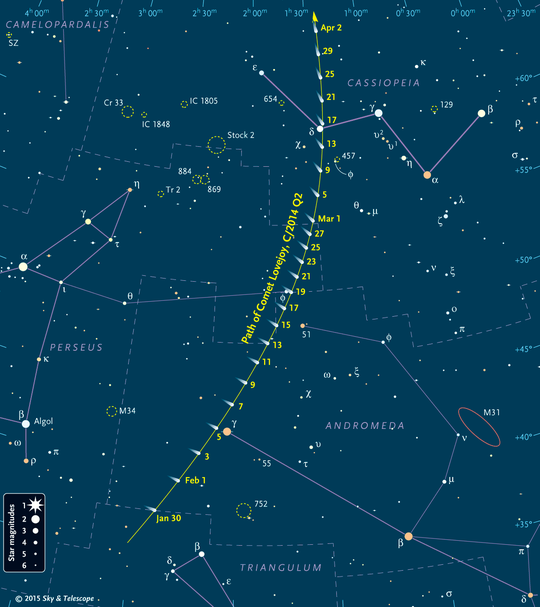
Position of Comet Lovejoy January to Early April 2015. Click for full-sized image
February 2015 Sky Charts
Click each image to see a full-size Sky Chart:
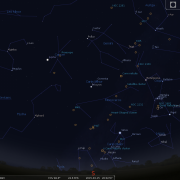 |
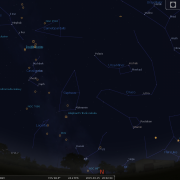 |
| Looking South Mid March - 20:00h |
Looking North |
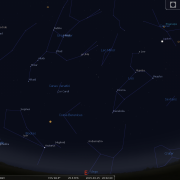 |
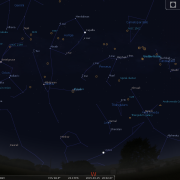 |
| Looking East Mid March - 20:00h |
Looking West Mid March - 20:00h |
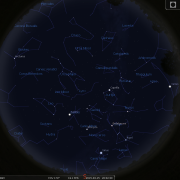 |
|
| Overview Mid March - 20:00h |
Image Credits:
- Planets and Comets where not otherwise mentioned: NASA
- Comet Lovejoy Position: Sky & Telescope Magazine
- Sky Charts: Stellarium Software
Events
 Observe the night sky with us at the Bruce Observatory, Whitby School
Observe the night sky with us at the Bruce Observatory, Whitby School
Observing Nights are held weather permitting: check for a relatively clear sky before leaving home. If in doubt, Mark can be reached on 07886069339
Please note the college drive gate is now operated via a electronic key code - so anyone wishing to attend must be at the car park at the top of the drive by 19:00hrs - unless an arrival time has been arranged with Mark/Keith.
 Observe the night sky with us at the Bruce Observatory, Whitby School
Observe the night sky with us at the Bruce Observatory, Whitby School
Observing Nights are held weather permitting: check for a relatively clear sky before leaving home. If in doubt, Mark can be reached on 07886069339
Please note the college drive gate is now operated via a electronic key code - so anyone wishing to attend must be at the car park at the top of the drive by 19:00hrs - unless an arrival time has been arranged with Mark/Keith.
 Observe the night sky with us at the Bruce Observatory, Whitby School
Observe the night sky with us at the Bruce Observatory, Whitby School
Observing Nights are held weather permitting: check for a relatively clear sky before leaving home. If in doubt, Mark can be reached on 07886069339
Please note the college drive gate is now operated via a electronic key code - so anyone wishing to attend must be at the car park at the top of the drive by 19:00hrs - unless an arrival time has been arranged with Mark/Keith.
 Whitby School - Room H1.
Whitby School - Room H1.
In Members' monthly meetings we usually take a tour of the night sky for the coming month using the Planetarium program. Have talks and presentations on various topics of astronomy/space etc, and discuss future events etc. New members welcome.

